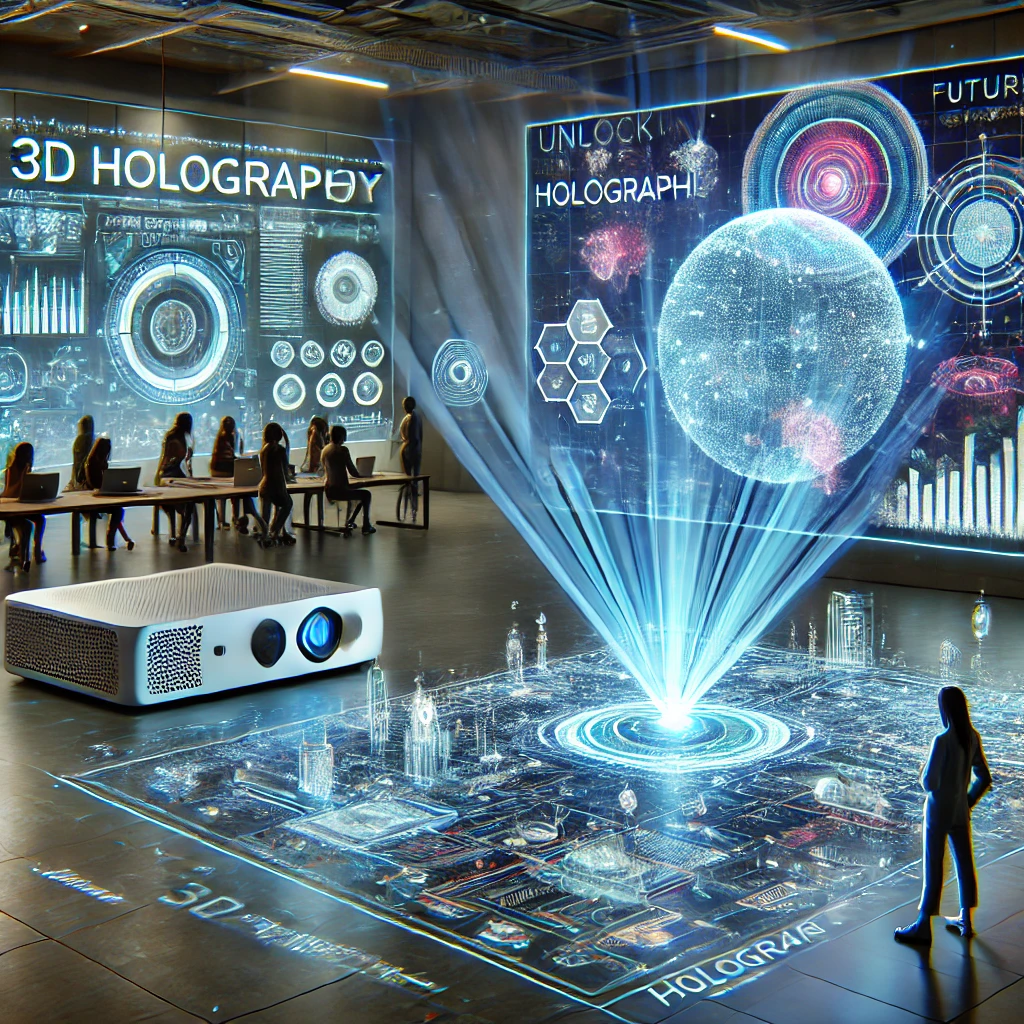Technologists together with marketers, educators, and artists are showing growing fascination toward 3D hologram projectors during recent years. The technology allows people to see lifelike 3D images floating without screens or special glasses in midair from all viewing perspectives. Holograms provide a transformative ability to exist in our reality.
Traditional 2D projections or screens differ from 3D hologram projectors because these devices produce immersive three-dimensional floating images for dynamic application usage in various fields. These projectors supply businesses and educational institutions with a fresh method to present their digital content. This article discusses the operational methods behind 3D hologram projectors while showing their uses across industries before forecasting their role in future visual technology advancements.
What is a 3D Hologram Projector?
Modern light and laser technology enables 3D hologram projectors to display three-dimensional images which seem to levitate midair. The technology behind holograms generates depth illusions which users can perceive from different angles because they do not require flat display surfaces.
The most prevalent method for hologram projection relies on laser-based technology among various existing methods. The technology accomplishes realistic full-color three-dimensional projections through light interference mechanisms which produce diffraction patterns that create mock-ups of actual objects together with environments.
The central operation of 3D hologram projection exists in controlling light patterns to generate three-dimensional imagery. The holographic images extend beyond flat displays by becoming active in open space which results in viewer immersion and complete interactivity.
How Does a 3D Hologram Projector Work?
The operational principles of a 3D hologram projector deserve attention because they become interesting to study. The general process of 3D hologram projection progresses as follows:
A laser along with coherent light sends energy to a holographic display medium. Light from lasers is chosen for hologram projection because lasers generate precise and steady light beams.
The light source produces two distinct beams by interference which function as the object beam and reference beam respectively. The two interfering light beams produce a diffraction pattern when they meet.
A special projection medium consisting of usually holographic film or plate records the interference pattern to capture light intensity and phase information. After light beams are recorded on this surface, the 3D projection becomes possible.
Traditional 2D displays lack the ability of 3D holograms to present images from numerous viewing perspectives because the hologram displays full depth perception when observed from different directions just like a solid object.
The newest 3D hologram projectors support live overhaul of holographic images as users move or engage with their display because of their dynamic functionality. 3D holograms in the air create an outstanding immersive display effect because they realistically reproduce objects and scenes as if they actually float.
Types of 3D Hologram Projectors
Multiple 3D hologram projectors exist in the market which possess separate feature sets and operational capabilities. Different versions of 3D Hologram Projectors exist and these include:
1. Laser-based 3D Hologram Projectors
Holograms at high levels of quality can be generated through the use of laser beams produced interference patterns. The high resolution quality of holographic images surpasses alternative methods which makes them suitable for business-oriented applications and professional applications. The industrial sectors that rely on accurate and visually appealing displays typically employ laser-based projectors in healthcare, entertainment, and scientific research fields.
2. Holographic Displays Using Pepper’s Ghost Effect
This technique represents an established approach to build three-dimensional images which continues being widely recognized today. Holograms appear through reflective surfaces which incorporate glass and mirrors into a reflective display. The results through this method excel in display quality but laser projectors offer superior depth and realness to images.
3. Volumetric 3D Projectors
Modern holography receives its advances through the new technology of volumetric projectors. Volumetric projectors utilize smoke and mist or rotating panels as medium surfaces to display images which results in genuine 3D presentation. Public events together with concerts and exhibitions benefit the most from these projectors because they generate realistic visual displays.
4. Pyramid Hologram Projectors
Hologram projectors work as basic tools by showing images through a projection system aimed at the inner walls of clear pyramid structures. A holographic image stands suspended in the middle of the pyramid structure as it generates a dramatic visual scene. 3D hologram projectors serve most frequently in retail displays and exhibitions and promotion events.
Applications of 3D Hologram Projectors
3D hologram projectors have wide-ranging industrial applications throughout different industries. The listed applications show their current utilization scenarios:
1. Entertainment and Live Events
Holographic technology creates a buzz in the entertainment world because it enables legendary personalities and show performances to appear as if they are still alive. Audiences can have the concert experience of Tupac Shakur at Coachella 2012 through his holographic performance even though he passed away.
The music industry employs holographic technology during concerts through multidimensional visual and audio presentations which adds the advantage of a futuristic stage production.
Stage productions employ 3D hologram projectors to develop full-bodied three-dimensional stage elements including theatrical settings and main cast members along with special visual effects that improve the audience experience.
Visitors can experience unforgettable theme park attractions due to holographic technology that recreates characters and sets to life.
2. Marketing and Advertising
The industry of marketing employs 3D hologram projectors as instruments to deeply engage target consumers. Retail businesses and shopping facilities display their products through holographic video presentations which provide exclusive visual perspectives to their customers. The car dealership presents an immersive holographic image of their complete car model that gives patrons a realistic exploration opportunity.
Monthly rebates from utility providers are also possible through interactive holographic advertising that enables users to interact and view 3D demonstrations of products.
3. Education and Training
The education sector obtains major improvements through 3D holograms by leveraging 3D models that support educational methods. The medical academic institutes utilize 3D hologram simulations to enable students to explore anatomical structures as well as touch and examine virtual 3D human body components for enhanced practical learning.
Educating students with 3D holograms in STEM subjects such as biology and physics along with chemistry results in improved comprehension of difficult concepts through interactive 3D learning methods.
Online learning has become popular which led holographic technologies to develop advanced virtual classrooms that enable effective three-dimensional communication between teachers and students.
4. Healthcare
The healthcare sector advances medical operations along with patient care through the introduction of 3D hologram projector technology. Healthcare professionals benefit from 3D hologram technology since they can view patients’ anatomy through real-time displays so they execute challenging surgical procedures more efficiently.
Through 3D holographic projections physicians obtain better diagnoses of patient conditions by viewing medical scan results (MRIs and CT scans) in three dimensions.
5. Architecture and Design
3D holographic technology transforms how architects and designers can see architectural designs and structural as well as interior concepts. Architects and designers make possible virtual 3D building models through which clients experience their projects by conducting digital tours before actual construction starts.
Product manufacturers utilize holographic technology to produce 3D model prototypes of their upcoming products so they can enhance their conception during pre-production development.
The Future of 3D Hologram Projectors
3D hologram projectors will become modernized and widely accessible for everyday use because their development continues to progress. Three major developments are expected for this technology along with other advancements:
- The technology of holographic projection is improving to attain enhanced resolution which creates more genuine and clearer 3D visualizations.
- The progress of technology will deliver smaller holographic projectors at affordable prices to the consumer market.
- When AI and AR join forces with holographic display technology it results in advanced interactive and customized holographic experiences for users.
Conclusion
The 3D hologram projector demonstrates the current advancements in visual technology which will guide its influence over different industries into the future. The future of business operations and educational growth along with entertainment sector progress depends on permanent 3D holographic technology applications.
Technology development will create expanded possibilities with holographic applications that will result in creative and practical solutions. 3D hologram projectors have established their pivotal position which will shape how we observe and correspond with the environment that surrounds us.





